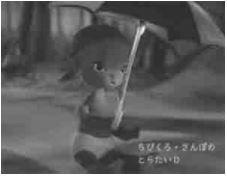A thorough review of "Little Black Sambo's Torajiro"! Explaining its charms and problems

"Chibikuro Sambo no Torataiji": A historic masterpiece of Japanese animation■ Public Mediatheater ■ Original MediaAnime Original ■ Release dateNovember 1956 ■Frequencies18 min ■ Number of EpisodesEpisode 1 ■Original StoryBy Helen Berman and Frank Dobias ■ DirectorTadanori Mochinaga ■ ProductionDentsu Film Company, Puppet Film Factory, Kiichi Inamura ■ StorySambo is proud of his new clothes and parasol that his parents gave him, and as he walks through the jungle, three tigers appear one after the other, threatening to eat him. Each time, Sambo gives them the clothes and the umbrella and escapes danger. Now wearing their new gear, the tigers start fighting, claiming to be the king of the jungle, but they all end up dying. The fight is so heated that the tigers melt and turn into butter. Sambo's family makes donuts out of the butter and eats them with joy. Source: History of Japanese Animation Films, p. 249 ■ExplanationBy the third film, the staff had more time to relax and were able to make it more freely. The gag at the end where the tiger turns into butter was a masterpiece. It won the top prize at the 1982 Educational Film Festival. In 1956, it was specially selected by the Ministry of Education. In 1957, it was ranked 10th in the 5th Kinema Junpo Cultural Film Top Ten. In 1957, it won the top prize at the 1st Vancouver International Film Festival. This win in Vancouver later led to the production of a puppet film in collaboration with Video Craft. Hani Susumu wrote an appropriate film review in the January 1957 issue of Living Design (published by Bijutsu Shuppansha), which I will reproduce here. "The most backward area in the Japanese film industry today is animation. As far as this area is concerned, the Japanese film industry is almost barren. In particular, films in which "things" that are not cartoons or animations move are almost nonexistent, with the exception of Ofuji Nobuo's paper cutting crafts. The appearance of "Little Black Sambo" (two volumes) should be welcomed. This is the third work completed by the puppet movie production company that produced "Little Black Sambo," and it can be said that their rapid development has borne splendid fruit in this film. It is said that puppet movies from twenty years ago left a "strange and gruesome impression" on Imamura Taihei, author of "Cartoon Movies." However, the techniques used in today's puppet films, mainly from the Czech Republic, are far more lifelike than cartoons and are able to develop a brighter world of storytelling. The first enjoyable thing about this film is that the puppet of the main character, the black boy Sambo, is extremely charming. Close-ups of Sambo overjoyed to receive a black and white parasol as a souvenir, and then crying after the tiger takes away not only his parasol but also his jacket and trousers, leaving him in just his underwear, fully captured the audience's attention. This is the success of Kawamoto Kihachiro's puppets and Mochinaga Tadahito, who animated them. The three villains Of the various characters, including the tigers and the two playful, long-armed baby monkeys, my favorite was the donkey. The "actor" who captured the animal's characteristics well, but added humorous exaggerations to his round forehead and small mouth, also had a very good feel to his "performance." After a fight with his tiger buddies, the tiger turned into butter. When Sambo's father suggested they make sweets out of it, the donkey stood in the background shaking his head in delight, which was really amusing. When this kind of film is made in black and white, it is the sets that bear the greatest disadvantages. No matter how real it may be, Even if it does become a film, it cannot compete with live-action films, let alone animated films. However, to draw children into the story, it is still necessary to have a sense of authenticity. In a sense, this job is to create the rhythm that is the basis of the film. Even though the setting is a hot southern country, which makes it easy to rely on preconceived images, Eguchi's art properly resolved the confusion that existed in his previous film, Five Little Monkeys. The inclusion of a shot of the tiger-patterned donuts from Black and White being fried in an actual Chinese pan with butter made from tigers probably speaks to the composure of the staff. This series clearly considers children to be the main audience, which in turn demands the digestion of advanced technology, but considering how poorly the Japanese film industry is at nurturing new ideas, isn't there an obligation for everyone to cheer it on? It's about time Japan produced a film with high-class beauty. Source: History of Japanese Animation Films, pp. 248-249 ■ Main staff Produced by Dentsu Eigasha, Ningyo Eiga Seisakusho, Kiichi Inamura Original story by Helen Berman, text by Frank Dobias Illustrations by Natsuya Mitsuyoshi Translated by "Little Black Sambo" (Iwanami Children's Books) ■Detailed review"Little Black Sambo's Adventure" is a Japanese animated film released in 1956 that was highly praised for its unique story and puppet animation techniques. The film is based on the original story by Helen Berman and Frank Dobias and was produced jointly by Dentsu Eigasha and Ningyo Eiga Seisakusho. The film features a stellar cast including director Tadahito Mochinaga, screenwriter Haruo Mura, art direction by Junji Eguchi, and puppeteer Kihachiro Kawamoto. The story begins with Sambo walking through the jungle after receiving new clothes and a parasol from his parents. Three tigers appear and threaten to eat Sambo, but Sambo cleverly escapes by giving them the clothes and the parasol. The tigers put on Sambo's clothes and start claiming to be the kings of the jungle, but they end up falling out and turning into butter. Sambo's family uses the butter to make donuts, which they happily eat, for a humorous ending. The appeal of this work lies above all in its humor and puppet animation technique. In particular, the final scene in which the tiger is turned to butter left a strong impression on the audience, eliciting many laughs. The puppet of the main character, Sambo, is also extremely charming, carefully crafted down to the smallest detail, from the way he holds a black and white parasol to the way he cries after the tiger steals his clothes. The directing skills of Mochinaga Tadahito, who was in charge of the movements of these puppets, are also superb, drawing the audience into the story. Furthermore, this work won many awards, including the Educational Film Festival and Kinema Junpo Cultural Film Top Ten, and was highly praised for its artistry and entertainment value. In particular, winning the Grand Prize at the 1957 Vancouver International Film Festival was a catalyst for Japanese animation films to gain international recognition. It is a very interesting anecdote that this award later led to the production of a puppet film in collaboration with Video Craft. Also, according to Hani Susumu's film review, this work is evaluated as a step to break the backwardness of animation films in the Japanese film industry. In particular, it emphasizes that the technique of puppet animation is more lifelike than cartoon films, and that it is necessary to have a sense of verisimilitude to draw children in. Junji Eguchi's art also resolves the confusion of his previous work, "Five Little Monkeys," and the finished product shows the staff's ease. ■ Recommendations and ratings"Little Black Sambo's Battlefield" is a work that can be enjoyed by both children and adults, and its humor and technical skill have not faded even today. It is a must-see, especially for fans of puppet animation and lovers of good old Japanese movies. This work also marks an important page in the history of Japanese cinema, and is a valuable resource for understanding the development of animated films. When viewing this work, please pay attention to the following:
"Little Black Sambo's Adventure" is a masterpiece of Japanese animation from the 1950s, and its artistry and entertainment value continue to fascinate many people even today. We hope that you will feel a part of Japanese film history through this work. |
Recommend
Review and impressions of "School Days Extra Edition": Unexpected developments and character depth
School Days Bangaihen - A deep love story and its...
The box office of "The Wandering Earth" will exceed 4 billion yuan and surpass "Wolf Warrior 2" in no time
The official Weibo account of The Wandering Earth...
The Chinese trailer of the sci-fi blockbuster "Dune" was released, and the magnificent and desolate sandworms of Dune were unveiled
Today (September 10), the sci-fi action blockbust...
The Japanese Buzzword Awards 2022 are announced, and the heroine of the animated film "One Piece" Uta won the championship
The Japanese "Top 100 Internet Slangs" ...
The new poster of "Wonder Woman 2" is exposed. The goddess is so beautiful with her hair up
Recently at the Licensing Expo 2019 in Brazil, th...
Soccer Fever: What's the appeal of the anime about racing through the frenzy of the soccer pitch?
Soccer Fever: An animated masterpiece depicting t...
Star Wars: The Rise of Skywalker Magazine Cover: Red and Blue Light Sword Duel
"Star Wars: The Rise of Skywalker" will...
A sequel is being made 30 years later! Tom Cruise's "Top Gun 2" is scheduled to be released in North America
The military blockbuster "Top Gun 2" st...
PAWORKS original animation "Maya no PUNCH" new trailer released, will be broadcast on July 8
The original animation "Maya no PUNCH" ...
Akatonbo: Reevaluating the moving songs of everyone
"Akatonbo" - Looking back on the famous...
Ojamanga Yamada-kun - Appreciated for its unique blend of humor and deep themes
"Ojamanga Yamada-kun": The appeal of th...
ZOMBIE-LOAN review: A deep dive into the world of zombies and contracts
"ZOMBIE-LOAN": A soulful drama set betw...
In commemoration of the release of "Sadako DX" on October 28, the terrifying Sadako taxi reappears in Tokyo
The new chapter of the classic Japanese horror fi...
Resident Evil: Welcome to Raccoon City first trailer released tomorrow
The first trailer for Constantin Film's reboo...
Tanuki-san Big Hit - A deep review of the fascinating story and characters
"Tanuki-san Daiatari": The appeal and b...









